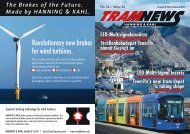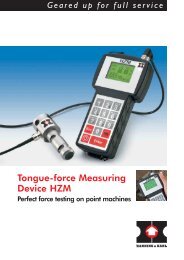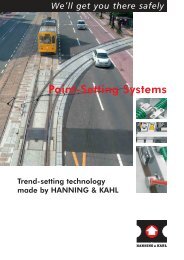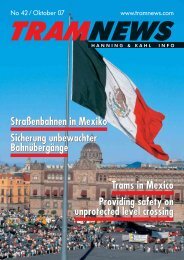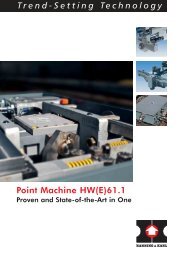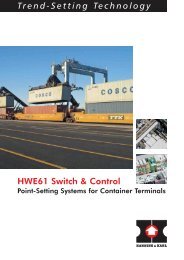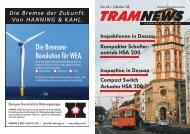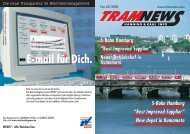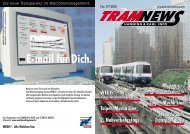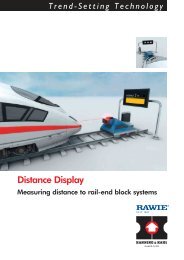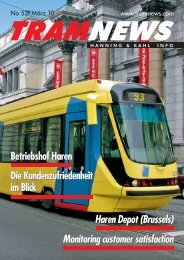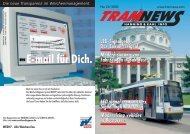Getting You There Safely - Hanning & Kahl
Getting You There Safely - Hanning & Kahl
Getting You There Safely - Hanning & Kahl
You also want an ePaper? Increase the reach of your titles
YUMPU automatically turns print PDFs into web optimized ePapers that Google loves.
<strong>Getting</strong> <strong>You</strong> <strong>There</strong> <strong>Safely</strong><br />
Control and Safety Systems<br />
Safe Transportation All Along The line
<strong>Getting</strong> <strong>You</strong> <strong>There</strong> <strong>Safely</strong><br />
Control and Safety Systems<br />
Safe Transportation All Along The Line<br />
Control and safety systems made by HANNING & KAHL set technical<br />
standards and are successfully deployed all over the world. Our partners<br />
are transport authorities, private and industrial railways, point<br />
manufacturers and consultants, none of whom are prepared to compromise<br />
on safety.<br />
Competence since 1928<br />
The technical superiority of HANNING & KAHL<br />
modules and systems results from almost a century<br />
of experience: the company has been producing<br />
components for rail-based transportation<br />
since 1928 and consolidating this core<br />
competence ever since.<br />
We offer customers an extensive, systematic<br />
range of products for rail-based transportation,<br />
and have the right components, systems, techniques<br />
and equipment for your application.<br />
HANNING & KAHL is certified according to all<br />
major standards: ISO 9001, ISO 14001,<br />
OHSAS 1801 and IRIS (International Railway<br />
Industry Standard).<br />
The best solution for you<br />
HANNING & KAHL control and safety technology<br />
is individually engineered and designed for<br />
each particular application. By accompanying<br />
you through the project-planning phase, we<br />
quickly learn your requirements and can apply<br />
our experience right from the beginning – to<br />
your advantage.<br />
Before equipment or components are supplied,<br />
they are put through their paces in our Quality<br />
Assurance Centre, where a wide range of test<br />
environments and methods are available. On<br />
request, we also offer a Factory Acceptance Test<br />
(FAT) during which the product is assessed and<br />
tested in the presence of our customers. FAT<br />
also provides instruction in the use of the innovative<br />
technology.<br />
HANNING & KAHL control and safety concepts<br />
are the result of successful symbioses of economically-efficient<br />
series production and individual<br />
design. This leads to technically precise and<br />
reliable solutions with fast returns for operators<br />
– another reason why our products are at home<br />
all over the world.
1 I S Y S T E M C O M P O N E N T S<br />
1.1 Control systems<br />
1.2 Vehicle detection<br />
1.3 Event recorders<br />
1.4 Communication systems<br />
1.5 Diagnosis<br />
1.6 Interfaces<br />
2 I A P P L I C A T I O N S<br />
2.1 Point controllers<br />
2.2 Signalling installations<br />
2.3 Safety installations for level crossings (SILC)<br />
2.4 Depot controllers<br />
2.5 HN-EOW electric locally-set points<br />
2.6 HW61 Switch & Control<br />
2.7 Equipment for testing vehicles<br />
2.8 Point heater systems<br />
2.9 Depot management systems<br />
2.10Passenger information systems<br />
3 I A C C E S O R I E S<br />
3.1 Signals and signal poles<br />
3.2 Vehicle detection for communication systems<br />
3.3 Receiver loops for communication systems<br />
3.4 Rail boxes<br />
3.5 Insulated tie bars<br />
3.6 Local operating elements<br />
3.7 Control cabinets and plinths<br />
3.8 Pole fuses<br />
3.9 Lightning arresters<br />
3.10Cable und connecting material<br />
4 I S E R V I C E<br />
4.1 Project management<br />
4.2 Quality assurance<br />
4.3 Documentation<br />
4.4 Workshops<br />
4.5 Testing and service equipment<br />
4.6 24-hour on-call service<br />
page 5<br />
page 5-6<br />
page 7<br />
page 7<br />
page 8<br />
page 9<br />
page 10<br />
page 10-11<br />
page 12-13<br />
page 12-13<br />
page 14<br />
page 14<br />
page 15<br />
page 15<br />
page 15<br />
page 15<br />
page 16<br />
page 17<br />
page 17<br />
page 17<br />
page 18<br />
page 18-19<br />
page 19<br />
page 19<br />
page 19<br />
page 19<br />
page 20<br />
page 21<br />
page 21<br />
page 21<br />
page 22<br />
page 22
<strong>Getting</strong> <strong>You</strong> <strong>There</strong> <strong>Safely</strong><br />
1| SYSTEMCOMPONENTS<br />
1.1 Control systems<br />
The Vital Processor System HN-P is modular and tailored to<br />
customer requirements. At the heart of the system is twochannel<br />
microprocessor technology with an exemplary safety<br />
profile up to SIL 3.<br />
Basic installations and complex requirements can be efficiently<br />
implemented with the Vital Processor System HN-P.<br />
Features like the electronic event recorder, connection of<br />
external systems and additional components, and integration<br />
into a networked communication structure ensure a high<br />
degree of flexibility.<br />
Today, complex demands are made on vital processor<br />
systems as core components in control and safety technology,<br />
such as automatic train control and electronic interlocking,<br />
which call for safety integrity level (SIL) 4. To fulfil<br />
these tasks, we have designed the new vital processor system<br />
HVIP, HANNING & KAHL Vital Interlocking Processor.<br />
The concepts we have elaborated consider current and future<br />
market requirements, customer wishes and modern technology.<br />
The HANNING & KAHL Public Process Data Interface<br />
(PPDI) in conjunction with modern LAN interface technology<br />
ensures future-proof realisation of process visualisation and<br />
telecontrol. Complex installations are simplified by division<br />
into control segments with high availability. An adequate<br />
number of interfaces and data services has been defined<br />
and developed. Standard peripheral equipment can be connected<br />
via a special BUS.<br />
In the HVIP, we have kept to the successful concept of modular<br />
design and flexible extension. The processor systems can<br />
be adapted to control requirements and scaled accordingly.<br />
1.2 Vehicle detection<br />
When it comes to registering vehicles, determining positions<br />
and securing routes, you have these processes safely under<br />
control with HANNING & KAHL systems for vehicle detection.<br />
To secure routes and passively detect rail vehicles,<br />
HANNING & KAHL adapts its own systems to project requirements.<br />
Vital Processor System HN-P<br />
HANNING & KAHL Vital<br />
Interlocking Processor HVIP<br />
5
6<br />
HFP track circuit for detection of wheelshunt<br />
When axles produce a short circuit (< 0.3 Ohm, max. 5 uH)<br />
in the track area, rail vehicles are recognised by the electronics.<br />
This way, the HFP track circuit detects the vehicle passively<br />
and does not require insulated rail joints.<br />
The effective length of the HFP track circuit is limited solely by<br />
short circuit connectors from rail to rail. Double track circuits<br />
are constructed by adding another track circuit receiver in<br />
the track, to detect the driving direction of vehicles. Track circuit<br />
length can range from 12 to 400 metres.<br />
HFK mass detector circuit for detection of vehicle mass<br />
The robust system operates via an electric oscillating circuit,<br />
which indicates a change in frequency when a rail vehicle<br />
crosses the HFK mass detector coil with its metal mass. For<br />
safe protection against humidity and mechanical strain,<br />
mass detection coils and electronic components are cast in a<br />
plastic frame.<br />
HSK blocking circuit for detection of combination of<br />
wheelshunt and vehicle mass<br />
The HSK blocking circuit recognises the entry of rail vehicles<br />
passively by the wheelshunt (< 1 Ohm, max. 5 uH) produced<br />
and it recognises exiting vehicles by the reduction in vehicle<br />
mass detected. The HSK blocking circuit functions without<br />
insulated rail joints, its effective range is limited by short circuit<br />
connectors. Standard length can be 3 to 12 metres.<br />
Axle counters<br />
Wheel sensors before and behind the control segment count<br />
the axles of entering and exiting trains, ensuring that one<br />
train has left the section before another can enter. Untimely<br />
point setting (haste, lack of concentration, sabotage) or<br />
incorrect "Drive" signals are thus precluded.<br />
Overhead line contacts<br />
The HON system is a non-contact overhead line contact<br />
which is attached to the catenary wire and reacts to the carbon<br />
brush on the pantograph. The system includes a buffer<br />
stage for galvanic separation of voltages and an evaluating<br />
module.<br />
Automatic train control<br />
In areas where “Driving at Sight” is not possible, e.g. in tunnels<br />
or at speeds higher than 70 km/h (BOStrab § 49 Abs.<br />
2.2), trains must be technically monitored and controlled in<br />
the event of dangerous irregularities. Inductive or magnetic<br />
immobilisers installed at the Drive/Stop signals are activated<br />
when a signal which indicates stop is passed. Brakes are<br />
applied automatically if driving errors occur.<br />
HFP track circuit<br />
Axle counters<br />
Overhead line contacts
<strong>Getting</strong> <strong>You</strong> <strong>There</strong> <strong>Safely</strong><br />
1.3 Event recorders<br />
In order to be able to reliably reconstruct and document<br />
events on signalling installations or controllers in the event of<br />
a malfunction, an electronic event recorder which works<br />
independently of the rest of the controller logic is deployed.<br />
The event recorder can be deployed in all HANNING &<br />
KAHL controllers and also in other makes.<br />
Memory capacity can record several hundred runs.<br />
Interrogation is possible via laptop on location or remote.<br />
Events can be visualised graphically.<br />
1.4 Communication systems<br />
HANNING & KAHL HCS communication systems are optimally<br />
tuned for information exchange between vehicles, the<br />
wayside and central control rooms. Performance profile ranges<br />
from transmission of manual setting commands to twoway<br />
exchange of information. Avail of the safety and convenience<br />
of HANNING & KAHL communication systems for the<br />
following applications, for example:<br />
Point setting<br />
Route setting<br />
Influencing of signalling installations (traffic acceleration)<br />
Passenger information<br />
CAD/AVL systems (ITCS)<br />
Data collection for diagnosis purposes<br />
Vehicle tracking<br />
HCS-R communication system<br />
The HCS-R communication system has proven itself in operation<br />
a thousandfold all over the world. With state-of-theart<br />
microprocessor technology, the HCS-R system is extremely<br />
flexible and can be used in multiple applications. It allows<br />
wireless transmission of commands and information from<br />
vehicles to the wayside (one-way) and integration of the<br />
HCS-R system into networks and management systems.<br />
HCS-V communication system<br />
The two-way communication system HCS-V facilitates wireless<br />
transmission of information and commands from vehicles<br />
to wayside and vice versa. The HCS-V system consists of<br />
vehicle and wayside equipment and has the same performance<br />
characteristics as the HCS-R system described above.<br />
The state-of-the-art technology with two-way design offers<br />
many application possibilities and more advantages.<br />
HCS-P communication system<br />
The HANNING & KAHL HCS-P system is based on modern<br />
RFID or WPAN. In contrast to other well-known communication<br />
systems, HANNING & KAHL technology works with<br />
much higher frequencies in the microwave range. Thanks to<br />
the narrow band range and high carrier frequency, the<br />
system is interference-resistant, making communication between<br />
vehicles and wayside much more stable and safer<br />
than with conventional systems.<br />
Event recorders<br />
HCS wayside equipment<br />
HCS carborne equipment<br />
7
8<br />
1.5 Diagnosis<br />
To reduce service work to a minimum, HANNING & KAHL<br />
has developed a family of diagnosis systems.<br />
FADIS – the route diagnosis system<br />
When points and wayside/line equipment are equipped with<br />
FADIS ® , you are always informed of point condition. Possible<br />
disruptive factors are signalled. <strong>You</strong> can react in good time<br />
and thus ensure the availability of your line network. FADIS ®<br />
facilitates extensive remote diagnosis and provides unsurpassed<br />
transparency in infrastructure management – very<br />
useful when planning maintenance work. The data acquired<br />
can be stored in a database (network) and made available<br />
for other applications (e.g. TuneQ).<br />
TuneQ – Tuning your Equipment<br />
TuneQ profits above all from the fact that HANNING & KAHL<br />
as a supplier of infrastructural equipment is involved in development<br />
right from the beginning, thus laying the ideal foundation<br />
for successful infrastructure-data management. Timeconsuming<br />
acquisition of infrastructure data is reduced to a<br />
minimum by qualified provision of equipment data, CAD<br />
diagrams, sub-assembly catalogues and parts lists in electronic<br />
form. TuneQ adheres to standard 456 of the VDV<br />
association of German transport authorities.<br />
The TuneQ equipment manager is the core component of<br />
the system. In this component, all infrastructure objects to be<br />
represented are tracked from the beginning of the planning<br />
phase until write-off. Depending on type, objects can be divided<br />
into interchangeable sub-assemblies and also components.<br />
Evaluation of the history of installations and installation<br />
parts is a particularly important function of the system.<br />
To administer all the information available on the equipment<br />
in the system, it is not sufficient to record equipment master<br />
data in the designated dialogues. <strong>There</strong>fore, we have integrated<br />
a document management system DMS, via which all<br />
available documents can be stored with a link to the corresponding<br />
installation.<br />
The malfunction data furnished by connected diagnostic<br />
systems and manual recording facilitate detailed TuneQ<br />
Analysis of the equipment, providing manufacturers and<br />
maintenance staff all the information they need to derive an<br />
optimal maintenance strategy.<br />
Event viewer<br />
The event viewer is a higher-ranking event and malfunction<br />
memory, with which networked equipment can be visualised,<br />
giving an overall picture of events and malfunctions on several<br />
controllers. The event viewer is particularly indispensable<br />
on depots and networked systems.<br />
FADIS workstation<br />
Master data and picture and document<br />
administration with TuneQ<br />
Event viewer
<strong>Getting</strong> <strong>You</strong> <strong>There</strong> <strong>Safely</strong><br />
1.6 Interfaces<br />
We use powerful, modern technology to exchange data between<br />
controllers.<br />
Ethernet networking<br />
HANNING & KAHL deploys modern networking on the basis<br />
of industrial Ethernet. In particular when planning and designing<br />
depot controllers and wayside equipment, this technology<br />
facilitates maximum efficiency and flexibility.<br />
Connection to higher-ranking computer systems (Operate &<br />
Observe, control systems, depot management systems) is<br />
thus state of the art.<br />
Controller networks<br />
Local controllers are networked via LAN. A standard bus<br />
system guarantees safe communication and easy extension.<br />
Copper or fibre-optic cables can be used depending on<br />
customer requirements. Ring, star or redundant structures<br />
are possible.<br />
Telephone lines, GSM or GPRS<br />
HANNING & KAHL uses networking via existing communication<br />
channels such as telephone lines, GSM or GPRS to read<br />
out event recorders remotely, relate malfunctions and transmit<br />
FADIS data to a central control room.<br />
Advantage: Access via existing communication channels<br />
means cable investments are not necessary. Simple and at<br />
low cost.<br />
Networking via GSM or GPRS<br />
Controller networking<br />
Depot networking concept<br />
Redundant ring structure<br />
9
10<br />
2 I APPLICATIONS<br />
2.1 Point controllers<br />
HANNING & KAHL offers economically-efficient solutions in modular<br />
design even for the control of single points. After analysis of requirements,<br />
HANNING & KAHL configures customer-specific point controllers<br />
which function safely.<br />
At the heart of each HANNING & KAHL point controller is the innovative<br />
Vital Processor System HN-P. This powerful and stable system works with<br />
unsurpassed reliability and can be supplied with each commonly available<br />
detection and communication system. The point controllers fulfil the<br />
requirements of the German BOStrab and all international standards.<br />
The superior technology of HANNING & KAHL point controllers can also<br />
be deployed in multiple/sequence point controllers, which means that<br />
each unit can be extended by modules.<br />
2.2 Signalling installations<br />
HANNING & KAHL designs signalling installations for each individual<br />
application. HANNING & KAHL’s exemplary safety level complies with<br />
current standards. User-friendly operation ensures error-free sequences.<br />
The advantages include:<br />
Easy installation and commissioning<br />
High availability with low maintenance<br />
Integrated event recorder with convenient evaluation software<br />
Networking via fibre optics, bus systems etc.<br />
Single-line track safety devices<br />
If two-track operation is not possible for technical reasons; if it is interrupted<br />
by construction work or not economically efficient, driving operations<br />
are regulated by single-line track-safety devices. All HANNING & KAHL<br />
signalling installations are customized right from the project-engineering<br />
stage. We can offer you stationary and transportable equipment for connection<br />
of different types of switching equipment:<br />
Terminal loops<br />
At terminal stations and on line networks, vehicles have to change driving<br />
direction or park. This normally entails driving onto the opposite track<br />
(oncoming trains). This area must be secured with signalling technology<br />
to prevent collisions.<br />
Crossovers<br />
Crossovers which require signal protection are generally at the beginning<br />
and at the end of the line. They consist of electric points and a number of<br />
Drive/Stop signals. The task of crossovers is to guide trains into and out<br />
of stop station tracks safely and without delay. Controllers prevent collision<br />
and derailing.<br />
Crossovers
<strong>Getting</strong> <strong>You</strong> <strong>There</strong> <strong>Safely</strong><br />
Sidings<br />
Single-line track safety devices<br />
Single-line track safety devices<br />
11
12<br />
2.3 Safety installations for level crossings (SILC)<br />
HANNING & KAHL's modular SILC concept offers you solutions in different<br />
technical versions and price categories to provide safety at level crossings.<br />
SILC can be adapted to actual system environments while focussing<br />
on optimum cost-benefit ratio.<br />
A further advantage of the modular system: each SILC safety system<br />
can be adapted when safety or convenience requirements change. All<br />
HANNING & KAHL system components are optimally tuned to each other.<br />
The result is precision-engineered, objective-oriented solutions that only<br />
an experienced partner can offer. At HANNING & KAHL, you profit from<br />
decades of experience with consummate concepts and sophisticated solutions:<br />
logically-consistent, fully-fledged and functional equipment.<br />
2.4 Depot controllers<br />
<strong>You</strong> would like to reliably dispatch and move tram and light rail vehicles<br />
safely, and organise and control sequences? HANNING & KAHL systems<br />
for control of depots make complex sequences transparent and safe.<br />
HANNING & KAHL depot controllers prove themselves in daily operation<br />
all over the world. Users benefit from the following advantages:<br />
Basis of design engineering "Driving at sight“(SIL 2, if requested up to<br />
SIL 3)<br />
Route selection central or/and local<br />
Automatic route cancellation<br />
Modern VDU workstation or conventional control panel<br />
Storage of several route entries and partial delocking<br />
Possibility to set single points<br />
Integration into depot management systems possible<br />
Distributed intelligence, LAN and fibre optic technology<br />
Realisation of all runs which the track geometry allows, side protection<br />
possible<br />
Vehicle identification via HCS-R, HCS-V, HCS-P, HCS-Z or other makes<br />
such as VETAG, VECOM, IMU, ZUB and many more, for automatic<br />
route selection<br />
Individual and economic solutions are possible with the modular design<br />
of HANNING & KAHL depot controllers.<br />
Depot controllers
<strong>Getting</strong> <strong>You</strong> <strong>There</strong> <strong>Safely</strong><br />
O&O workstation<br />
13
14<br />
2.5 HN-EOW electric locally-set points<br />
On secondary lines and depots and on industrial and factory<br />
railways, line systems have to fulfil specific requirements. The<br />
electrical locally-set point HN-EOW streamlines rail operations<br />
and relieves the strain on drivers simply and efficiently.<br />
When “driving at sight“, the train driver can set points<br />
without getting out of his cab. He simply has to push the<br />
pushbutton at an operating station directly beside the track.<br />
The points are set electrically and the setting command is<br />
displayed visually. Rail vehicle detection switches and point<br />
position indicators ensure a high level of safety. Further HN-<br />
EOW components are available for even greater convenience<br />
and functionality – when ordering or later.<br />
2.6 HWE61 Switch & Control<br />
Technical equipment deployed in container terminals is<br />
exposed to extreme conditions. The HWE61 Switch & Control<br />
system was developed for the particular requirements of container<br />
terminals. Engineers and operators all over the world<br />
are convinced by the legendary stability of HANNING &<br />
KAHL point machines. For special requirements: all components,<br />
including the point controller and signals, are embedded<br />
in the ground and can be crossed by heavy road traffic.<br />
Embedded installation ensures free transportation routes<br />
and prevents vandalism and unauthorized activation. The<br />
system is applied where availability requirement is high but<br />
space is limited, and conventional installations cannot be<br />
implemented.<br />
HWE61 Switch & Control<br />
Electric locally-set HN-<br />
Point heater controller
OW<br />
HCP<br />
<strong>Getting</strong> <strong>You</strong> <strong>There</strong> <strong>Safely</strong><br />
2.7 Equipment for testing vehicles<br />
Vehicle failures on the line or accidents caused by malfunctions<br />
are costly for transport authorities. With HANNING &<br />
KAHL's new testing equipment, transport authorities can now<br />
test vehicle systems on their depots – automatically, conveniently<br />
and economically. Precautionary vehicle inspection<br />
can be integrated into routine sequences, decisively enhancing<br />
the safety standard. HANNING & KAHL equipment for<br />
testing vehicle systems is an investment with rapid returns.<br />
A number of measuring techniques are available to test technical<br />
parameters:<br />
Wheelshunt<br />
Communication systems<br />
Vehicle identification<br />
Automatic train control (ATC)<br />
Current collectors /pantographs<br />
The technical parameters can be visualised via the route diagnosis<br />
system FADIS or a depot management system.<br />
2.8 Point heater systems<br />
HANNING & KAHL has a wide selection of point heater<br />
systems with different voltage ranges and capacities for wintery<br />
regions. Point heater controllers ensure that point tongues<br />
do not freeze up/are not blocked by snow slush in winter.<br />
The point heater controllers can work independently with<br />
their own temperature and humidity sensors or be controlled<br />
from a central control room. Interfaces to FADIS and HN-P<br />
are integral.<br />
2.9 Depot management systems<br />
Before trains begin their daily operations, detailed planning,<br />
dispatch and monitoring tasks have to be performed on<br />
depots. Vehicles, parking places and workshop appointments<br />
are allocated, allowing for the requirements of timetable<br />
provision, technical vehicle service and maintenance<br />
work.<br />
2.10 Passenger information systems<br />
Modern and customer-oriented transport systems provide<br />
dynamic passenger information. In cooperation with<br />
Verkehrsautomatisierung Berlin GmbH (VAB), HANNING &<br />
KAHL offers a modular product range for the construction of<br />
visual passenger information systems. The main components<br />
are systems for recording process data, a control and operating<br />
level, system communication and display systems.<br />
Equipment for testing vehicle systems<br />
Depot management<br />
Passenger information systems<br />
15
16<br />
3 I ACCESSORIES<br />
3.1 Signals and signal poles<br />
When it comes to representing signal aspects, LED signals<br />
are the superior technical and economic solution.<br />
A large number of signal aspects are available for safety and<br />
information purposes. We manufacture customer-specific<br />
signals for all order sizes – i.e. even if you just order 1. LED<br />
technology holds enormous potential for the future. LED signals<br />
are available in different colours. For multifunctional<br />
applications we use our innovative combi-signals.<br />
Intelligent matrix signals are also available for representation<br />
of almost every desired signal. HANNING & KAHL LED<br />
signal transmitters fulfil SIL 3 and are compatible with all<br />
common housing systems.<br />
HANNING & KAHL offers a wide assortment of metal and<br />
plastic poles from simple straight versions to mast-arms. All<br />
poles are prepared for easy and fast mounting of signal<br />
transmitter housings.
<strong>Getting</strong> <strong>You</strong> <strong>There</strong> <strong>Safely</strong><br />
3.2 Vehicle detection<br />
HFK mass detection coils<br />
HFK mass detection coils are specially designed for track installation<br />
and HFK mass detection circuits. Different versions are available depending<br />
on the application:<br />
HFK coil with external tuning module<br />
HFK coil with external tuning module, mounted in concrete polymer<br />
Mounting kit for installation of HFK coil on sleepers in open track<br />
HFP track circuit transformers<br />
Transmitter and receiver transformers supplied by HANNING & KAHL<br />
have proven themselves in HFP track circuits over decades:<br />
Symmetric connection cable (installation in the centre of a track in a rail<br />
box)<br />
Asymmetric connection cable (one-sided installation in a rail box)<br />
Symmetric connection cable (installation in the centre of a track without<br />
rail box)<br />
The transformers have protected connections for connecting cable to the<br />
controller.<br />
HSK blocking circuits<br />
HANNING & KAHL supplies all track installation components required for<br />
operation of blocking circuit systems. The components have proven themselves<br />
in years of practical application and are available in numerous versions:<br />
insulated tie bars, short circuit connector cables, blocking circuit<br />
connector cables, rail boxes, tuning capacitors, input/output junction<br />
boxes, connecting cable.<br />
3.3 Receiver loops for communication systems<br />
HANNING & KAHL’s receiver loops, coupling coils and antennas are<br />
tuned to receive. Available in different versions for all current communication<br />
systems, the equipment comes with appropriate mounting devices<br />
and attachment materials for installation in common permanent way.<br />
3.4 Rail boxes<br />
HANNING & KAHL’s practical rail boxes protect electric connections on<br />
rails. The patented rail boxes can be screwed onto the inside or the outside<br />
of all rail profiles or welded on with mounting ribs. The cables are<br />
connected to the rail via independent contact screws inside the rail box.<br />
Rail boxes can also be supplied with a special coating for stray-current<br />
insulation on request. Depending on the requirement, different versions<br />
can be supplied for applications such as:<br />
Traction-current return-conductor and collector return-conductor connections<br />
Track connectors<br />
Connection of operating and protective earths<br />
Track circuit connections<br />
Connection of short-circuit connectors<br />
Protective box for track circuit components (transformers, capacitors<br />
etc.)<br />
Protective box for cable connectors and cable sleeve<br />
Insulated multi-connection<br />
HFK mass detection coils<br />
HFK track circuit transformer<br />
HKS blocking circuits<br />
Receiver loops for communication<br />
systems<br />
17
18<br />
3.5 Insulated tie bars<br />
Direct rail contact must be avoided when assembling track,<br />
mass detector or blocking circuits. In these track segments<br />
the gauge is held by insulated tie bars.<br />
Carefully designed and manufactured, insulated tie bars<br />
supplied by HANNING & KAHL guarantee a high degree of<br />
functional safety. They are available for all gauges and rail<br />
profiles and also in special dimensions, if required. Insulated<br />
tie bars have a central insulation point and can be insulated<br />
full length against stray current on request.<br />
3.6 Local operating elements<br />
Local operating elements ensure convenient setting of several<br />
points on the way to a destination track.<br />
Route-setting boards<br />
Route-setting boards provide more convenience when several<br />
points have to be set (e.g. point fans) on the way to destinations.<br />
Simple user guidance, e.g. self-explanatory display<br />
dialogues, allows staff to set one or more routes. These are<br />
defined and can be stored via starting track and destination<br />
track buttons. All points en route to destinations are automatically<br />
established and their setting and status is visualised. It<br />
is thus no longer necessary to set each point individually.<br />
HPTS intelligent selection stations<br />
The intelligent selection station HPTS facilitates selection of<br />
destination tracks by communication with the central control<br />
room. The train driver identifies himself with his PIN number<br />
and enters the code for the destination track.<br />
An illuminated display allows representation of contextdependent,<br />
local-language texts. Entries are made via a<br />
hard-wearing ten-key keyboard with additional function<br />
keys. The components are in a UV-resistant plastic housing.<br />
The following interfaces are available for data communication:<br />
Ethernet, CAN, RS485, RS232. HPTS is freely programmable<br />
and supports standard network services such as<br />
FTP, HTTP and SMTP.<br />
Pushbuttons<br />
The operating station is directly beside the track. Train drivers<br />
can set points per pushbutton without getting out of the cab.<br />
This saves time, relieves driving staff and makes rail operations<br />
a lot safer. Handling is clear and simple. Visual signals<br />
indicate whether the setting command has been executed.<br />
Insulated tie bars<br />
Route-setting boards<br />
HPTS intelligent selection stations Pushbuttons
<strong>Getting</strong> <strong>You</strong> <strong>There</strong> <strong>Safely</strong><br />
Pushbutton stations, key switches<br />
Depending on requirements, pushbutton stations and key<br />
switches are manufactured in different versions:<br />
robust pushbutton stations with integrated illuminated<br />
pushbuttons<br />
electronic pushbutton stations with ten-key keypad<br />
fitted with electronic interface, which displays feedback<br />
and information to the operator via a built-in display<br />
individual designer solutions<br />
3.7 Control cabinets and plinths<br />
Customer and application-specific requirements with regard<br />
to size, finishing, accessibility, convenience and economic<br />
efficiency call for different types of control cabinets. Control<br />
cabinets made of glass-fibre reinforced plastic (GRP) are<br />
light and break-proof. Control cabinets made of aluminium<br />
offer advantages when exposed to direct sunshine and in<br />
tropic regions. They can also be equipped with a removable<br />
rear wall. Control cabinets made of sheet steel are stable<br />
and allow the use of swivelling frames.<br />
3.8 Pole fuses<br />
To easily disconnect power from control cabinets, the power<br />
lines for controllers and point heaters are usually pre-fused<br />
before the control cabinet. These pole fuses (mains fuses)<br />
can be supplied with porcelain fuses or with circuit breakers<br />
which are mounted in weather-proof plastic housings.<br />
Depending on the application, they can be designed for pole<br />
or wall mounting and for different voltages and currents.<br />
3.9 Lightning arresters<br />
Where contact wire voltage is required for operation of point<br />
heater controllers and other types of controllers, lightning<br />
arresters protect the voltage supply lines from overvoltages<br />
(e.g. lightning). Installed with a clearance of max. 30 m,<br />
lightning arresters are usually installed on the line power<br />
poles with holders and mounting aids.<br />
2.10 Cable and connecting materials<br />
All cables which have to fulfil particular requirements are<br />
made especially for HANNING & KAHL. The special-purpose<br />
cables deployed in track, blocking and mass detector circuits<br />
ensure high levels of safety and availability. All other cables<br />
for signals and point machines can also be acquired from<br />
HANNING & KAHL.<br />
Pushbutton station<br />
Control cabinets and plinths<br />
Lightning arrester and pole fose<br />
19
20<br />
4 I SERVICE<br />
4.1 Project management<br />
Meticulous project planning is essential for smooth execution<br />
of construction projects. It prevents technical and organisational<br />
errors from the word go, errors which can cause<br />
delays and have expensive consequences. Well-devised project<br />
management pays off. The HANNING & KAHL team<br />
provides competent and committed assistance with the following<br />
tasks:<br />
Calculation of braking and slip distances<br />
Analysis of track diagrams and proposals for optimal vehicle<br />
detection<br />
Determination of signal locations and request points<br />
Compilation of system requirement specifications<br />
Creation of schematic diagrams<br />
Creation of cable diagrams<br />
Processing of given CAD diagrams<br />
Compilation of documents for determination of driving<br />
operations<br />
Site supervision<br />
Project management<br />
As-built documentation for approval bodies<br />
Benefit from our long years of experience in project management<br />
and in the execution of major construction projects.<br />
1<br />
2<br />
3<br />
4<br />
1. Calculation of braking and slip<br />
distances<br />
2. Project and deadline monitoring<br />
3. Creation of schematic diagrams<br />
4. Processing of given CAD<br />
diagrams
<strong>Getting</strong> <strong>You</strong> <strong>There</strong> <strong>Safely</strong><br />
4.2 Quality assurance<br />
Quality assurance and final inspection are performed on<br />
HANNING & KAHL equipment with due diligence and attention<br />
to detail. HANNING & KAHL installations and components<br />
are subjected to extensive simulation in our test laboratories<br />
before supply.<br />
Different power supplies, network sockets, mobile test stations<br />
and PCs ensure variable and realistic test conditions.<br />
FAT is generally performed in the presence of customers,<br />
familiarising them with the innovative technology. The<br />
HANNING & KAHL team is also on hand to answer questions<br />
and advise.<br />
4.3 Documentation<br />
In line with their high safety level, all HANNING & KAHL<br />
installations and components are documented thoroughly<br />
and precisely. Along with each product, our customers receive<br />
structured operating manuals with graphic representations<br />
and photos in the file format of their choice (e.g. PDF).<br />
Technical data and functional descriptions of the individual<br />
components are documented with precision. Setting, maintenance<br />
and service work are described in a clear manner with<br />
photos.<br />
HANNING & KAHL product documentation contains:<br />
Installation drawings<br />
Electric circuit diagrams<br />
Final assembly inspection protocol<br />
Safety data sheet and certificate of conformity<br />
Spare-part catalogue<br />
4.4 Workshops<br />
HANNING & KAHL workshops combine theory and practice<br />
– the latter being particularly appreciated by our customers.<br />
Workshops are offered in different languages. On request,<br />
we design workshops on the particular units which you have<br />
installed. We would be pleased to submit a quotation.<br />
<strong>You</strong> can find our seminar program on the Internet at:<br />
www.hanning-kahl.de<br />
FAT with customers at HANNING & KAHL<br />
Content management<br />
Training on the customer's site<br />
21
22<br />
4.6 Testing and service equipment<br />
Working closely together with its partners, HANNING & KAHL<br />
has developed practical testing equipment and service devices,<br />
specially aligned to the requirements of the light rail sector,<br />
e.g.: HN-P tester, HFP tuning device, HCS-R-PS testing<br />
equipment for wayside equipment, HCS-V-PS testing equipment<br />
for wayside equipment and HN power tool kit.<br />
This equipment offers optimum support when trouble shooting,<br />
recording test results and planning service work.<br />
Whether assembling or commissioning, inspecting or performing<br />
maintenance work, repairing or overhauling:<br />
HANNING & KAHL testing and service equipment and our<br />
on-site work help to avoid unnecessary costs by identifying<br />
malfunction sources at an early stage.<br />
4.5 24-hour on-call service<br />
Should problems ever arise with your HANNING & KAHL<br />
equipment, we won't leave you out in the cold. Please contact<br />
our malfunction management without delay! Email the<br />
details of the malfunction to:<br />
service@hanning-kahl.com<br />
for processing by our new malfunction-management system.<br />
Our staff have the expertise and experience to help you. And<br />
they are also at your disposal on-call outside of office hours!<br />
24 hours a day/365 days a year.<br />
Telephone +49 1713360360<br />
HCS-R-PS testing equipment for wayside equipment<br />
HNP testing equipment<br />
Malfunction management
<strong>Getting</strong> <strong>You</strong> <strong>There</strong> <strong>Safely</strong><br />
Developing<br />
the Future Together<br />
Adelaide<br />
Amsterdam<br />
Antwerp<br />
Athens<br />
Barcelona<br />
Basel<br />
Bergamo<br />
Bern<br />
Bielefeld<br />
Birmingham<br />
Bochum<br />
Brandenburg<br />
Bremen<br />
Brünn<br />
Brussels<br />
Budapest<br />
Bucharest<br />
Bydgoszcz<br />
Cagliari<br />
Calgary<br />
Camden-Trenton, NJ<br />
Charleroi<br />
Chemnitz<br />
Chur<br />
Cottbus<br />
Croydon<br />
Dallas<br />
Danzig<br />
Darmstadt<br />
Denver<br />
Dessau<br />
Dresden<br />
Dublin<br />
Duisburg<br />
Düsseldorf<br />
Erfurt<br />
Eskisehir<br />
Essen<br />
Florence<br />
Frauenfeld-Wil-Bahn<br />
Freiburg<br />
Galati<br />
Geneva<br />
Ghent<br />
Gera<br />
Görlitz<br />
Gothenburg<br />
Graz<br />
Halberstadt<br />
Halle/Saale<br />
Heidelberg<br />
Helsinki<br />
Hong Kong<br />
Hudson Bergen<br />
Iasi<br />
Innsbruck<br />
Istanbul<br />
Jena<br />
Karlsruhe<br />
Kassel<br />
Katowice<br />
Konya<br />
Krakow<br />
Krefeld<br />
Kumamoto<br />
La Coruna<br />
Leipzig<br />
Linz<br />
Lisbon<br />
Lodz<br />
Los Angeles<br />
Madrid-Parla<br />
Magdeburg<br />
Milan<br />
Mainz<br />
Manchester<br />
Mannheim<br />
Melbourne<br />
Memphis<br />
Messina<br />
Minneapolis<br />
Moscow<br />
Neuenburg<br />
Nijgata<br />
Nordhausen<br />
Norrköping<br />
Nottingham<br />
Nuremberg<br />
Ostende<br />
Oslo<br />
Ostrava<br />
Philadelphia<br />
Phoenix<br />
Pittsburgh<br />
Portland<br />
Posen/Poznan<br />
Prague<br />
Rome<br />
Rostock<br />
Rotterdam<br />
Salt Lake City<br />
San Diego<br />
San Jose<br />
Sarajewo<br />
Sassari<br />
Schwerin<br />
Seattle<br />
Sofia<br />
Stuttgart<br />
Tacoma<br />
Tallinn<br />
Tenerife<br />
Tokyo<br />
The Hague<br />
Turin<br />
Valencia<br />
Velez-Malaga<br />
Warsaw<br />
Vienna<br />
Würzburg<br />
Zürich<br />
Zwickau
<strong>Getting</strong> <strong>You</strong> <strong>There</strong> <strong>Safely</strong><br />
Control and Safety Systems<br />
Safe Transportation All Along The Line<br />
Rudolf-Diesel-Straße 6<br />
33813 Oerlinghausen<br />
Deutschland<br />
Phone +49 5202 707-600<br />
Fax + 49 5202 707-629<br />
info@hanning-kahl.com<br />
www.hanning-kahl.com<br />
09/2010



